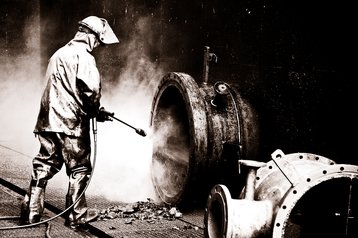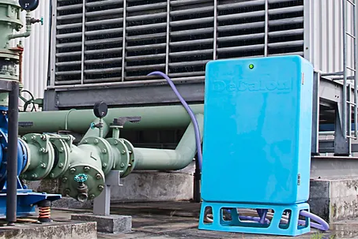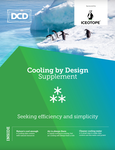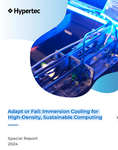Cooling towers are a grubby fact of data center life. Water is cycled through them, and they reject heat, either by evaporation or through a heat exchanger in a “dry” cooling tower.
Traditional evaporative cooling towers are not a great environmental choice. They consume millions of gallons of water. They potentially collect bacteria as the water and outside air are in direct contact, and accumulate limescale. Dry cooling towers also need cleaning and replenishing.
Cooling tower water will deposit limescale which clogs the pipes, causes corrosion, and makes the heat exchanger less efficient. The normal ways to treat and prevent limescale also have their problems.
Minerals build up in the "blow-down" water which has been condensed and drained from cooling equipment. Traditionally, chemicals are added to prevent a build up of calcium carbonate, but those chemicals, and the increasing concentration of calcium, mean that water can only go around a cooling circuit a certain number of times.
It also means that the eventually discarded wastewater is heavily contaminated, and when water is changed, the heat exchanger has to be pressure cleaned to remove scale.
Apply the electrodes
There’s an alternative, however. A small number of companies are using electrolysis to manage the existing chemicals in the water, rather than adding more. Players include Tiaano, Ensavior, Ball-Tech, and VST.
The idea seems to be advancing most in India and the Asia Pacific region, in wider air-conditioning and water treatment sectors.
Digital Realty is one of the first data center customers for the technique, and reports that blow-down water at its SIN10 data center in Singapore can now go through the cooling system three times as often, saving more than a million liters of water per month.
The eventual wastewater is also cleaner than that left from a chemically treated water cooling system.
Digital is using DCI (DeCaIon) units, which apply a small continuous electric current, partially electrolyzing the water, and making OH-ions which alter the acidity (pH) of the cooling water. Calcium and magnesium precipitate out as calcium carbonate and magnesium hydroxide, harmlessly, at the electrode.
The DCI boxes come from Singapore-based Innovative Polymers, and are already in use in sites such as hospitals, according to BK Ng, owner of Innovative and one of the developers of the product.
"Data centers have been slower to pick this up,” he told DCD. But he is hopeful that the Digital project will open the door to other data centers, which are getting more careful about water use.
Electrolytic descalers are an additional cost, and they also use a small amount of power continuously. Gavin Cherrie, at Allied Polymer's New Zealand distributor 2Plus, told us that the unit uses some 700kWh per year (i.e. an average of less than 1kW of power).
Ng says the payback is considerably greater in direct energy savings, as the units will actually “clean” the heat exchanger in the loop. Because calcium and magnesium are being removed from the water, the concentration is lowered, and the chemical equilibrium shifts, so limescale will dissolve everywhere else in the system.
Thermal transfer through the heat exchanger improves, and it needs less energy. This has a greater effect if the unit is installed in a cooling loop which is already furred up: "The irony is, if your system is already doing well, we will give you a little saving.”
Cherrie says that a catalytic unit can save 10 to 15 percent of the energy used in a cooling loop.
Ng puts this into context, explaining that energy saving is about 50 to 60 percent of the total savings the product makes. Water savings make up around 35 percent, and lower maintenance and chemicals costs provide making up the balance of the return on investment.
The practicalities
Cherrie says one electrolysis unit covers enough cooling water for 1.5MW, and installing it is a matter of connecting a box into each of the cooling loops.
“We take water out of the tower,” he says. “Using a small pump, we pump it through the electrolysis chamber, and then back into the loop.”
In use, the catalytic chamber needs cleaning, but this is made easier by periodically reversing the polarity of the anodes: “The calcium that has been collected, is rejected, and then flushed or drained,” Cherrie explains. Then the polarity is restored, and descaling continues.
“If you have a manifold, you can consolidate the number of units,” he explains. “If you had three 1MW cooling towers on a manifold, then you'd get away with having two units. If you have three 1MW cooling towers on individual loops, in parallel rather than in series, then then you might need three machines. The pipework design, to a degree, determines how many machines you need.”
But the capacity of the unit is very approximate, as any cooling system may be operated to a different level, the amount of use it gets will depend on the local weather patterns, and the amount of dissolved calcium in the local water will also vary.
“We look at the water chemistry and other factors, including the volume of the system,” he says. “All that goes into a quality model, which then generates the number of machines that you need, and I can calculate, quite accurately the savings you can make in terms of energy and water.”
Disposing of the calcium and magnesium carbonate that the system collects might seem to be an issue, but Cherrie says disposal is easy: “We encourage our customers to actually put it in the storm water drain. This is calcium and magnesium that needs to be bioavailable for the ecosystem.”
In the rain water there is dissolved carbon dioxide, and that reacts with the calcium carbonate in the waste water, to make calcium bicarbonate, which is bioavailable - it can be absorbed by plants and animals which need it.
“It's almost like a circular economy,” he says. “Calcium is a key element in ecology, and it remains in the water cycle.”
Electric reluctance
If the system is that good, why hasn’t it taken off before?
The technique was developed for electrochemical manufacturing processes, which make things like caustic soda and sodium, Cherrie explains: “These are manufactured using electrolysis. The guys that do that discovered they get calcium buildup on the electrodes, and frequently had to take the electrodes out of the electrolysis chambers and hydro blast them to get the scale off.”
Electrolytic descaling was developed for that application, and then offered to other sectors. But chemical descaling was already well established in the air conditioning market.
To make matters worse, the market was already being addressed by other “non-chemical” systems, which install a passive unit, often branded as an electrical or magnetic descaler. Cherrie says these are “pseudoscience” and don’t work.
“For years. It's been done with molecules. You’ve thrown the chloride into the water along with various inhibitors. That’s a discipline that has been around for a number of years. We know how it works and it's used in a number of industries,” he says.
Of course those chemicals aren’t great for the environment. “We used to throw in sulfuric acid. The trouble was, that dissolves all the metal. You don't want that to happen.
“So we used to put in hexavalent chromium and they basically turned all the surfaces into stainless steel, there's no corrosion.”
If hexavalent chromium sounds familiar, it was the pollutant released by Pacific Gas & Electric Company (PG&E) in Hinkley, California, which was eventually stopped after a lawsuit led by Erin Brockovich - later portrayed by Julia Roberts in an Oscar-winning movie.
The worst chemicals have been restricted, and the replacements don’t do such a good job of descaling, but the alternatives were no good till now, says Cherrie.
“There have been a number of non-chemical systems that have been promoted in the past. People talk about using magnets and all sorts. But the science doesn't work.”
Electrolytic catalysis provided a scientifically proven alternative, he says: “But, just because it's a non-chemical system, we’ve been up against it to get people to accept that this might work. It was quite difficult when we first launched the product to get people to try it.”






